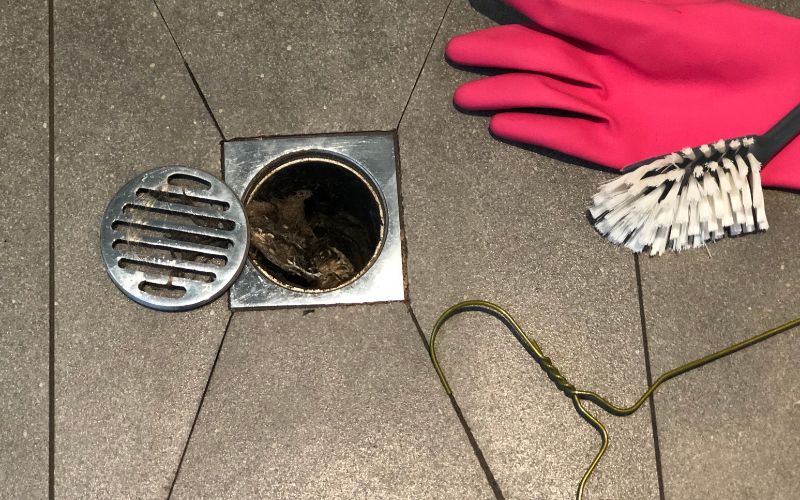Key Takeaways
- Hair, soap scum, and foreign objects are the most common causes of shower drain clogs.
- Simple DIY methods like removing visible obstructions, using a drain snake, and pouring hot water can often unclog a shower drain effectively.
- Natural cleaning solutions (such as vinegar and baking soda) are great for eco-friendly clog removal.
- Preventive tips (like using a drain cover and avoiding greasy products) help keep your shower drain clog-free.
- Professional help is advisable if basic methods don’t resolve the clog.
A clogged shower drain can turn your relaxing shower into a frustrating experience. You can quickly clear clogs and keep your shower drain running smoothly by understanding the causes, simple DIY fixes, and preventive measures.
Common Causes of Shower Drain Clogs
- Hair Buildup: Hair is one of the primary culprits in shower drain clogs. As hair sheds during showers, it tends to collect inside the drain, forming a net that traps soap, dirt, and other debris. Over time, this accumulation can completely block the water flow.
- Soap Scum and Product Residue: Many bath products contain fats and oils that don’t dissolve well in water. When combined with minerals in hard water, these substances form a sticky residue, or soap scum, that clings to the walls of the drain. Over time, this residue can build up and lead to a clog.
- Foreign Objects: Small objects like jewelry, hair clips, and other items can accidentally fall into the drain, especially if there’s no drain cover in place. These items might get lodged in the pipes. limiting water flow.
- Hard Water Mineral Buildup: Homes with hard water may experience mineral deposits accumulating in the drain over time. This buildup can narrow the pipes, making it easier for clogs to form.
- Greasy Products: Products like body scrubs and some moisturizers can leave a greasy residue in the drain. Over time, these residues can combine with hair and soap scum, creating tough-to-remove clogs.
Steps to Unclog a Shower Drain
Remove Visible Obstructions
Check if there are any apparent obstructions around the drain opening. Hair and other debris often get caught near the top, making them easily removed by hand. Wear gloves for this step to avoid contact with any residue.
Inspect the Drain Stopper
Some clogs are caused by drain stoppers that accumulate dirt and hair over time. Carefully remove the stopper and clean it thoroughly. Ensure to check inside the drain as well; sometimes, debris gets trapped just below the stopper.
Use a Drain Snake or Plumber’s Snake
A drain snake is a low-cost instrument that can be a lifesaver for clogged drains. Twist the snake to get it into the drain to catch the clog, and pull it out. Repeat the process if necessary, as this often helps clear stubborn blockages.
Pour Boiling Water
Soap scum can be dissolved with hot water, and loosen buildup in the drain. Boil a kettle of water and pour it slowly down the drain, careful not to splash. You can repeat this process several times for the best results.
Apply a Natural Drain Cleaner (Baking Soda and Vinegar)
A vinegar and baking soda combination is a practical, eco-friendly solution for breaking down clogs. Start by pouring Pour Half a cup each of vinegar and baking soda down the drain. Cover the drain for about 15 minutes, allowing the solution to fizz and break up the clog, then flush with hot water.
Consider a Commercial Drain Cleaner
Perhaps a commercial drain cleaner will work if the natural solutions aren’t strong enough. Follow the product instructions carefully and avoid overusing these chemicals, as they can damage your pipes over time.
Call a Professional Plumber
If all else fails and the clog persists, it may be time to call a professional. Persistent clogs can indicate a more significant plumbing issue that requires expert help.
Tips for Preventing Shower Drain Clogs
- Use a Drain Cover
A drain cover is a small, inexpensive addition that can make a big difference. It catches hair and debris before they enter the drain, significantly reducing the chance of clogs. Clean the cover regularly to keep it practical.
- Avoid Using Greasy Products in the Shower
Greasy or oily products can contribute to clogs by sticking to the sides of the pipes. If you use these products, consider rinsing the drain afterward with hot water to help break down any residue.
- Avoid Flushing Foreign Objects
Be cautious with what goes down the drain. Avoid flushing any items or products that could lead to a clog, such as dental floss, cotton swabs, or anything other than water and soap.
- Perform Regular Maintenance
Cleaning your drains periodically can prevent future clogs. Use natural drain cleaners like baking soda and vinegar, or flush the drain with hot water every few weeks to dissolve minor buildup before it becomes a more significant issue.
- Consider Using a Monthly Enzyme Cleaner
Some enzyme-based drain cleaners are safe for monthly use and help break down organic material like hair and soap scum. These cleaners are handy if you experience frequent clogs.
Frequently Asked Questions (FAQ)
Q1: How often should I clean my shower drain to prevent clogs?
A1: Aim to clean your drain once a month for best results. Regular maintenance can prevent buildup and keep water flowing smoothly.
Q2: Is it safe to use chemical drain cleaners?
A2: While effective, chemical drain cleaners can be harsh on your pipes if used too often. For eco-friendly and safer solutions, consider natural options like baking soda and vinegar, and save chemicals for stubborn clogs.
Q3: Can I use a plunger to unclog a shower drain?
A3: Yes, a plunger can sometimes help dislodge clogs. Ensure there’s enough water in the shower basin to cover the plunger’s rim, then press and pull to create suction and break up the clog.
Q4: What should I do if the clog keeps returning?
A4: Recurring clogs might indicate a more significant plumbing issue. In this case, it’s best to consult a qualified plumber to evaluate the issue and provide a long-term solution.
Q5: Are there preventive measures for drains in areas with hard water?
A5: Hard water can lead to mineral buildup, which can cause clogs. A water softener or regularly cleaning the drains with vinegar can help manage this issue.
Q6: What is the best way to dispose of hair after cleaning the drain?
A6: Throw it in the trash after removing hair from the drain rather than flushing it down the toilet or other drains to prevent clogging elsewhere.
By doing these things and taking precautions, you may maintain your shower drain clog-free and enjoy a hassle-free showering experience. However, if you encounter persistent clogs, don’t hesitate to contact a professional plumber for assistance. Need Emergency Drain Service? Contact Elizabeth Plumbing Drain Service Trusted Plumbers!


